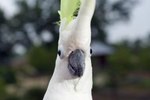
Tracking down a parrot’s background requires determination, and in some cases it may not be possible. Other times the leg band will give you information about the bird’s past and lead you to its current owner. The style of the band is the first clue: a solid ring means the bird was born in this country and the breeder applied it when the parrot was young. A band with a split in it means the bird was imported and the band was applied at that time.
Private Stations
The bands on parrots that have been imported into the United States through privately operated import stations have the station’s code as the first letter on the band. This will be C or O if the bird arrived in California, F for Florida, I for Illinois, M for Michigan, N for New York or T for Texas. The second letter identifies the importer, and must be checked against an importer’s code list to find the name. After the importer’s ID is a three-number code, which is the individual bird’s number and uniquely identifies it.
USDA
Birds brought in through government-operated import stations have leg bands that begin with either USDA or USD and include the appropriate station code, such as USDAA for a bird that arrived in the USDA station in Los Angeles. Most of the government stations were closed in 1992 and the records thrown away, making imported birds almost impossible to trace. The United States Department of Agriculture website states that the USDA may be able to find information on the year a bird was imported, but has no records of individual birds beyond that.
Parrot Clubs
If the bird was bred domestically and the breeder belonged to a parrot club, there’s a good chance that the leg band will adhere to the standards of that club. Typically, each band will contain the breeder’s identification number, the year the bird was hatched and a unique identification code for the bird. The band also may have a code indicating which state the breeder lives in and the particular parrot club to which he belongs. Start with the club to find the breeder and from there the bird usually can be identified.
Individual Breeders
Many times an individual breeder will make up his own leg band system. Since no standards exist for parrot leg bands, the information the band contains may or may not be complete. Without a bird club or other organization as a starting point, it may be difficult or even impossible to determine who the breeder was for any given bird. The band may contain unique identifying information for the bird, but it may not have the year it was hatched or any other data printed on it.
References
Photo Credits
-
Photodisc/Photodisc/Getty Images

